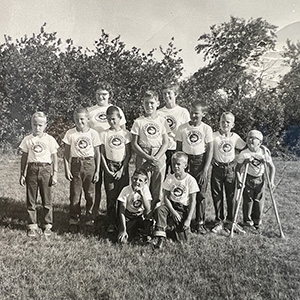History
EASTERSEALS
Easterseals’ roots were planted in Elyria, Ohio, in 1919 by prominent businessman Edgar F. Allen. After his son died in a streetcar collision, Allen became aware of the inadequate emergency medical facilities of the time. Inspired to make improvements, he led an effort to build, equip, and staff a new general hospital in Elyria. Allen then developed an interest in a boy who was hospitalized with a disabling condition, and saw a need for medical care for children with disabilities.

Allen began his lifelong service of helping people with disabilities. In 1919, he started the first state organization in Ohio to serve "crippled children." With headquarters in Elyria, the organization became known as the National Society for Crippled Children in 1921.
At the time of its founding, the National Society was the only voluntary agency speaking and acting on behalf of people with disabilities. The formation of other state societies soon followed. Their programs worked toward stimulating state legislation to provide medical care and education to children with disabilities. Other activities included sponsoring clinics, and school and hospital programs. The ever-popular "Easter Seals" stickers were adopted as fundraising in 1934, and the Easter lily became its national symbol in 1952.
Now known as Easterseals, Inc., the national organization is rated as one of the top-10 nonprofit organizations in the country providing services and programs for people with disabilities and special needs. Easterseals also played a key role in generating grassroots support for the passage of the Americans with Disabilities Act (ADA) in 1991, which is federal civil rights legislation prohibiting discrimination against people with disabilities in the areas of employment, transportation, public accommodations and communications.
The North Dakota Chapter of the National Society for Crippled Children and Adults was founded in 1947 in Jamestown, N.D. In those early years, The "Society" (as the North Dakota Chapter was referred to), began with the provision of speech and language screening. The Society's first employee, a speech therapist, traveled throughout the backroads of North Dakota in her station wagon, going into the homes of school children to test them for speech and hearing disabilities. It was determined that there was a strong need for speech therapy within the state. Consequently, the Society worked along with the state Legislature to have speech therapy included in the services provided by the N.D. Department of Public Instruction and to make speech therapy available throughout the state.
A few years later, an office was opened in a garage in Jamestown where a staff person worked to raise $125,000 for the Crippled Children's School to construct a new dormitory. This school is now the Anne Carlsen Center, which is also located in Jamestown, N.D. In the 1950s the Society's name was changed to Easter Seal Society for Crippled Children and Adults, or just North Dakota Easter Seals.
In the 1960s, North Dakota Easter Seals and the Elks Club established Camp Grassick on Lake Isabel south of Dawson, N.D. Together, the two organizations administered a summer camping program for children and adults with disabilities.
In 1975, North Dakota Easter Seals opened warm water therapy pools in Minot and Mandan. Although neither pool is open today, we make referrals to local hospitals and/or agencies that offer warm-water therapy.
In 1996, Easter Seals of North Dakota sought a merger with Goodwill Industries and its name became Easterseals Goodwill ND, Inc.
GOODWILL INDUSTRIES INTERNATIONAL
Goodwill Industries began more than 100 years ago when Methodist minister Edgar J. Helms accepted served as a settlement worker among the poor immigrants of Boston, Massachusetts. Helms became inspired to improve the immigrants' quality of life, so he took a burlap sack and began traveling to the wealthier areas of Boston asking for unwanted garments and other goods.

Poor men and women were put to work restoring the collected items, and learning trades and skills as they worked. Once the items were repaired, they were resold and the money was used to pay the wages of the workers. This cycle of donations, processing, resale and wages was the beginning of Goodwill Industries and remains essentially intact today.
Gradually, Goodwill Industries spread across the United States, offering programs to help the "unemployable" enter the work world. Although people with disabilities were never excluded from Goodwill Industries' programs, they did not become the major focus of the organization's work until the mid-1930s. It was during the Great Depression that Goodwill turned its attention to the vocational needs of America's people with disabilities. Over the years, as needs have changed, Goodwill has expanded its programs to include, once again, people who are socially and economically disadvantaged. Today, Goodwill serves people with a range of barriers to employment including a lack of education, welfare dependency, a criminal record or advanced age.
In 1996, to expand its mission, Easter Seals of North Dakota merged with Goodwill Industries International. This merger allowed Easter Seals the opportunity to create new revenue sources to fund its services.
Looking to the future, Easterseals Goodwill ND will continue developing new services such as career development and life-skills training. It is our hope that these types of services can be sustained over time and provide substantial benefits to the people in our region.